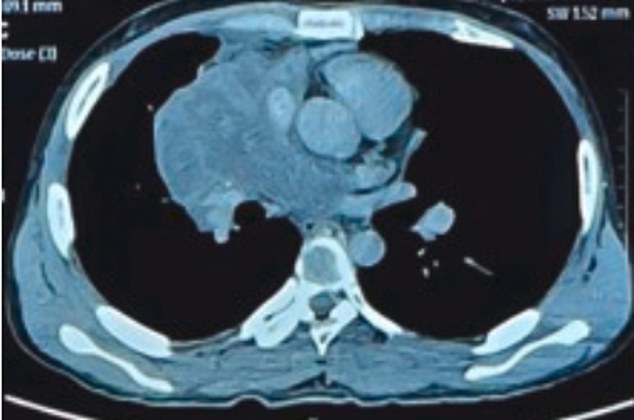Doctors Find One in a Million Cancer Cases in 23-Year-Olds After Adopting Common Habit
A twenty-something man was diagnosed with a one-in-a-million cancer that may have been caused by his e-cigarette addiction.
The 23-year-old man from Indonesia was diagnosed with a tumor called synovial carcinoma. About 70 percent of victims die from it.
The tumor had developed in the tissue between his lungs, pushing his heart to one side and preventing it from pumping blood properly.
The patient had been using e-cigarettes for about five years before he started having health problems, which had been bothering him for three months before he was diagnosed.
Vaping has been shown to increase the risk of cancer, but doctors cannot confirm whether this is linked to the new patient’s tumor.
The patient’s scan shows a mass on his right side, near his lungs, pressing against his heart (seen on the right side of the image, but it is the left side of his chest)

The young patient had been a regular e-cigarette user for about five years before being diagnosed
The young man was admitted to hospital with shortness of breath that lasted for about two months and worsened when he lay down. He also had chest pain and a cough for three months.
During that time he also lost 5 kilos.
Physical examination revealed that he had generalized weakness, an asymmetrical shape of his chest, less vibration felt through the upper right chest wall, a dull sound when tapped on the upper right side of his chest, and less breath sounds in the same area.
Are doctors started a series of imaging studies, including X-rays and CT scans.
One scan showed a tumor on the right side of his chest, near his lung. Another scan showed that the solid mass was compressing the arteries to the lung, the left side of the heart, a crucial artery to the right lung, and the right middle lobe of the lung.
The tumor was as long as a large tablet, as wide as a dinner plate, and as high as a medium-sized melon.
His heart was also surrounded by fluid and his lymph nodes were enlarged. Compression of various structures in the man’s chest reduced oxygen flow to the lungs, leading to breathing problems and impaired heart function.
Doctors said: ‘Synovial sarcoma appears macroscopically as a well-defined mass of variable size, ranging from 5 to 23 cm (about two to nine inches), with a soft to firm texture and invasion into surrounding tissues.

The mass pressed against his heart and other organs. It was about the length of a tablet and the width of a small cantaloupe.
‘Definitive diagnosis of synovial sarcoma can be challenging, even after tissue sampling. Immunohistochemistry can be helpful, but is insufficient because the tumor may resemble other soft tissue tumors histologically.’
Vaping has been linked to a higher risk of lung cancer. While it doesn’t produce cancer-causing smoke like cigarettes, the liquid in e-cigarettes contains thickeners and heavy metals that damage lung tissue.
A study from South Korea last year found that the health data of 4.3 million ex-smokers who switched to e-cigarettes were twice as likely to die from lung cancer, compared with those who quit abruptly.
Another study, this time from University College London and the University of Innsbruck, Austria, analyzed more than 3,500 buccal swab samples from smokers and vape users.
They found that epithelial cells, which typically line organs and are often the site of cancer development, showed significant granular changes in the mouths of smokers.
Similar changes were observed in the cells of e-cigarette users who had smoked fewer than 100 tobacco cigarettes in their lifetime.
The patient underwent surgery to remove the mass, called a resection, and then had to undergo three rounds of chemotherapy.
Synovial sarcoma is considered rare, accounting for approximately eight percent of tissue tumors, while in adolescents and young adults it accounts for 15 to 20 percent of cases.
Of every million people in the US, one to two are diagnosed with synovial sarcoma each year.
Doctors said: ‘Due to its irregularity, diagnostic errors are common. Histologically, synovial sarcoma can show different growth patterns… which increases the diagnostic challenge, especially in unusual locations.’
The prognosis for this type of cancer is generally poor: an estimated 37 percent of patients are still alive after five years.
After three rounds of chemotherapy, tests showed that the tumor had shrunk and the fluid around the lung had disappeared.
